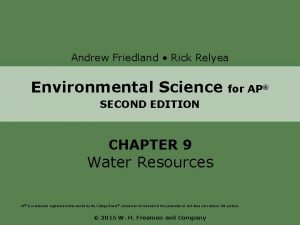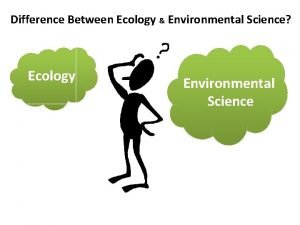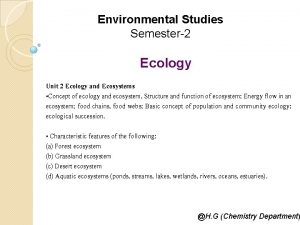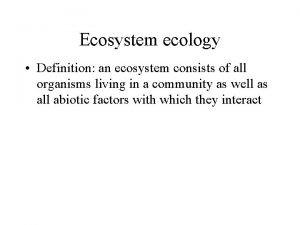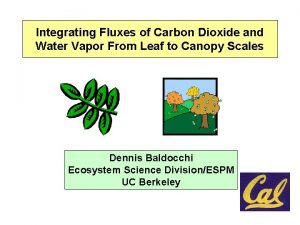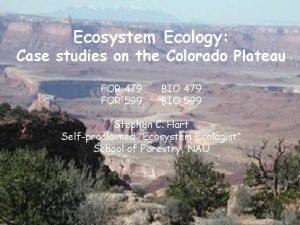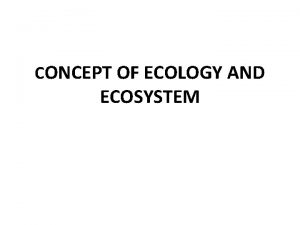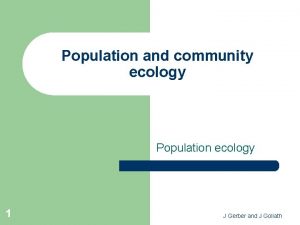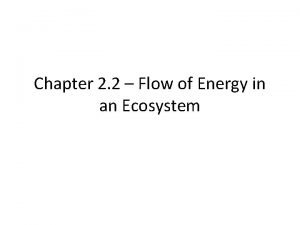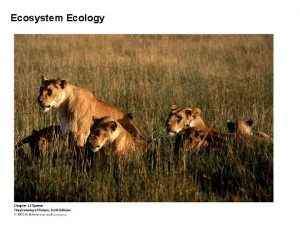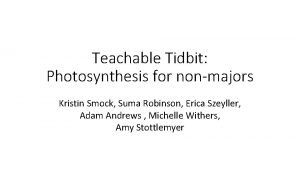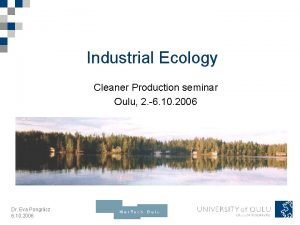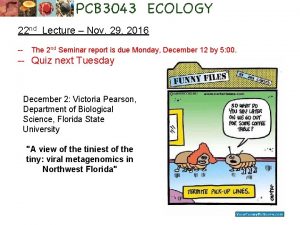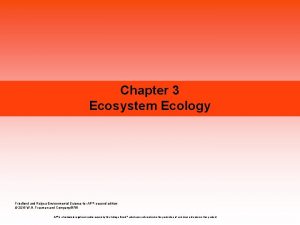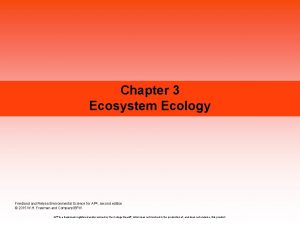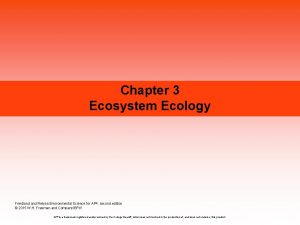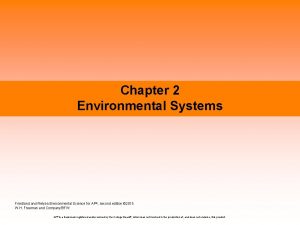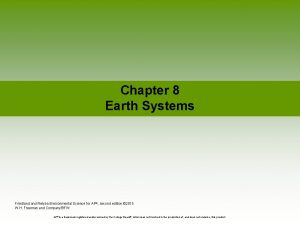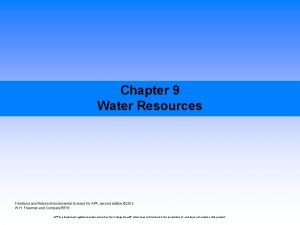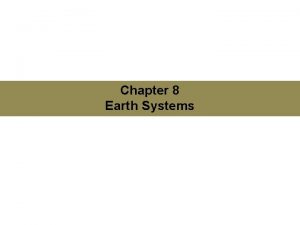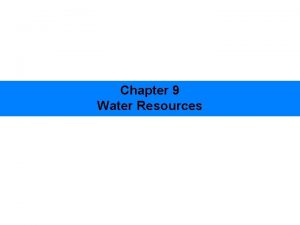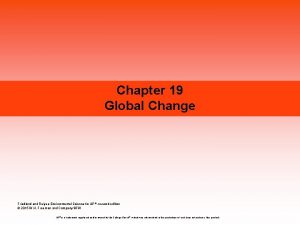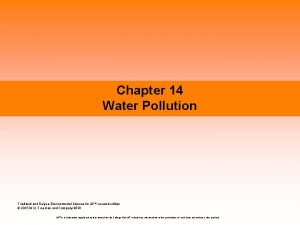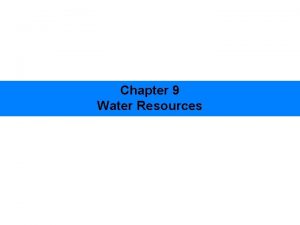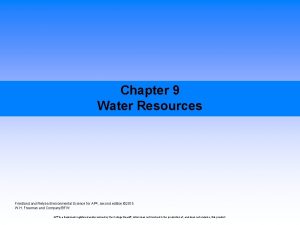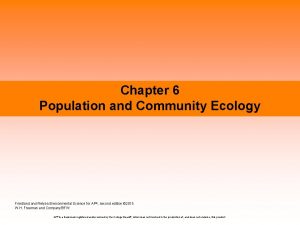Chapter 3 Ecosystem Ecology Friedland Relyea Environmental Science















- Slides: 15

Chapter 3 Ecosystem Ecology Friedland Relyea Environmental Science for AP ®, second edition © 2015 W. H. Freeman and Company/BFW AP® is a trademark registered and/or owned by the College Board ®, which was not involved in the production of, and does not endorse, this product.

Module 6 The Movement of Energy After reading this module you should be able to • Explain the concept of ecosystem boundaries. • Describe the processes of photosynthesis and respiration. • Distinguish among the trophic levels that exist in food chains and food webs. • Quantify ecosystem productivity. • Explain energy transfer efficiency and trophic pyramids.

Ecosystem boundaries are not clearly defined • Some ecosystems, such as a caves and lakes, have very distinctive boundaries. However, in most ecosystems it is difficult to determine where one ecosystems stops and the next begins. • Even though it is helpful to distinguish between two different ecosystems, ecosystems interact with other ecosystems. • Biosphere The region of our planet where life resides; the combination of all ecosystems on Earth.

Ecosystem Boundaries Large and small ecosystems. (a) The Greater Yellowstone Ecosystem includes the land within Yellowstone National Park and many adjacent properties. (b) Some ecosystems are very small, such as a rain-filled tree hole that houses a diversity of microbes and aquatic insects.

Photosynthesis captures energy and respiration releases energy • Producer-An organism that uses the energy of the Sun to produce usable forms of energy. Also known as Autotroph. • Photosynthesis-The process by which producers use solar energy to convert carbon dioxide and water into glucose. • Cellular respiration-The process by which cells unlock the energy of chemical compounds. • Aerobic respiration-The process by which cells convert glucose and oxygen into energy, carbon dioxide, and water. • Anaerobic respiration-The process by which cells convert glucose into energy in the absence of oxygen.

Photosynthesis and Respiration Photosynthesis and respiration. Photosynthesis is the process by which producers use solar energy to convert carbon dioxide and water into glucose and oxygen. Respiration is the process by which organisms convert glucose and oxygen into water and carbon dioxide, releasing the energy needed to live, grow, and reproduce. All organisms, including producers, perform respiration.

Energy captured by producers moves through many trophic levels • Consumer An organism that is incapable of photosynthesis and must obtain its energy by consuming other organisms. Also known as Heterotroph. • Herbivore A consumer that eats producers. Also known as Primary consumer. • Carnivore A consumer that eats other consumers. • Secondary consumer A carnivore that eats primary consumers.

• Tertiary consumer A carnivore that eats secondary consumers. • Trophic levels The successive levels of organisms consuming one another. • Food chain The sequence of consumption from producers through tertiary consumers.

Trophic Levels Simple food chains. A simple food chain that links producers and consumers in a linear fashion illustrates how energy and matter move through the trophic levels of an ecosystem. (a) An example of a terrestrial food chain. (b) An example of an aquatic food chain.

Trophic levels • Food web A complex model of how energy and matter move between trophic levels. • Scavenger An organism that consumes dead animals. • Detritivore An organism that specializes in breaking down dead tissues and waste products into smaller particles. • Decomposers Fungi and bacteria that convert organic matter into small elements and molecules that can be recycled back into the ecosystem.

Trophic Levels A simplified food web. Food webs are more realistic representations of trophic relationships than simple food chains. They include scavengers, detritivores, and decomposers, and they recognize that some species feed at multiple trophic levels. Arrows indicate the direction of energy movement. This is a real but somewhat simplified food web; in an actual ecosystem, many more organisms are present. In addition, there are many more energy movements.

Some ecosystems are more productive than others • Gross primary productivity (GPP) The total amount of solar energy that producers in an ecosystem capture via photosynthesis over a given amount of time. • Net primary productivity (NPP) The energy captured by producers in an ecosystem minus the energy producers respire.

Ecosystem Productivity Gross and net primary productivity. Producers typically capture only about 1 percent of available solar energy via photosynthesis. This is known as gross primary productivity, or GPP. About 60 percent of GPP is typically used for respiration. The remaining 40 percent of GPP is used for the growth and reproduction of the producers. This is known as net primary productivity, or NPP.

The efficiency of energy transfer affects the energy present in each trophic level • Biomass The total mass of all living matter in a specific area. • Standing crop The amount of biomass present in an ecosystem at a particular time. • Ecological efficiency The proportion of consumed energy that can be passed from one trophic level to another. • Trophic pyramid A representation of the distribution of biomass, numbers, or energy among trophic levels.

Ecosystem Efficiency Trophic pyramid for the Serengeti ecosystem. The amount of energy that is present at each trophic level is shown in joules (J). The pyramid assumes 10 percent ecological efficiency, but efficiencies can range from 5 to 20 percent across different ecosystems. For most ecosystems, graphing the numbers of individuals or biomass within each trophic level would produce a similar pyramid.
 Friedland and relyea environmental science
Friedland and relyea environmental science Rick relyea
Rick relyea Difference between environmental science and ecology
Difference between environmental science and ecology Liz friedland
Liz friedland Medienkonzepte friedland
Medienkonzepte friedland Difference between ecosystem and ecology
Difference between ecosystem and ecology An ecosystem consists of
An ecosystem consists of Ecosystem ecology
Ecosystem ecology Ecosystem ecology
Ecosystem ecology Difference between ecosystem and ecology
Difference between ecosystem and ecology Ecosystem ecology
Ecosystem ecology Principles of ecology 2 flow of energy in an ecosystem
Principles of ecology 2 flow of energy in an ecosystem Ecological productivity
Ecological productivity Ecosystem ecology
Ecosystem ecology Ecology ecosystem
Ecology ecosystem Ecosystem ecology
Ecosystem ecology
